HLTOUT007: Patient Transport Under Operational Conditions
VerifiedAdded on 2023/06/08
|18
|6771
|161
Homework Assignment
AI Summary
This HLTOUT007 assignment solution addresses the safe transport of non-emergency patients under operational conditions. It identifies relevant state documents on manual handling, outlines their guidelines, and lists recommended controls for handling people, including risk, hazard, engineering, administrative, and PPE controls. The solution also details key legislation, regulations, and codes of practice related to non-emergency patient transport, such as the Non-Emergency Patient Transport Act 2003 and associated regulations. Furthermore, it explains the specific protocols and requirements for safely transporting bariatric, pediatric patients, patients with carers, those requiring long-distance transport, and multiple patients simultaneously. The solution emphasizes the importance of qualified crew members and clinical staff in ensuring patient safety and well-being during transportation.
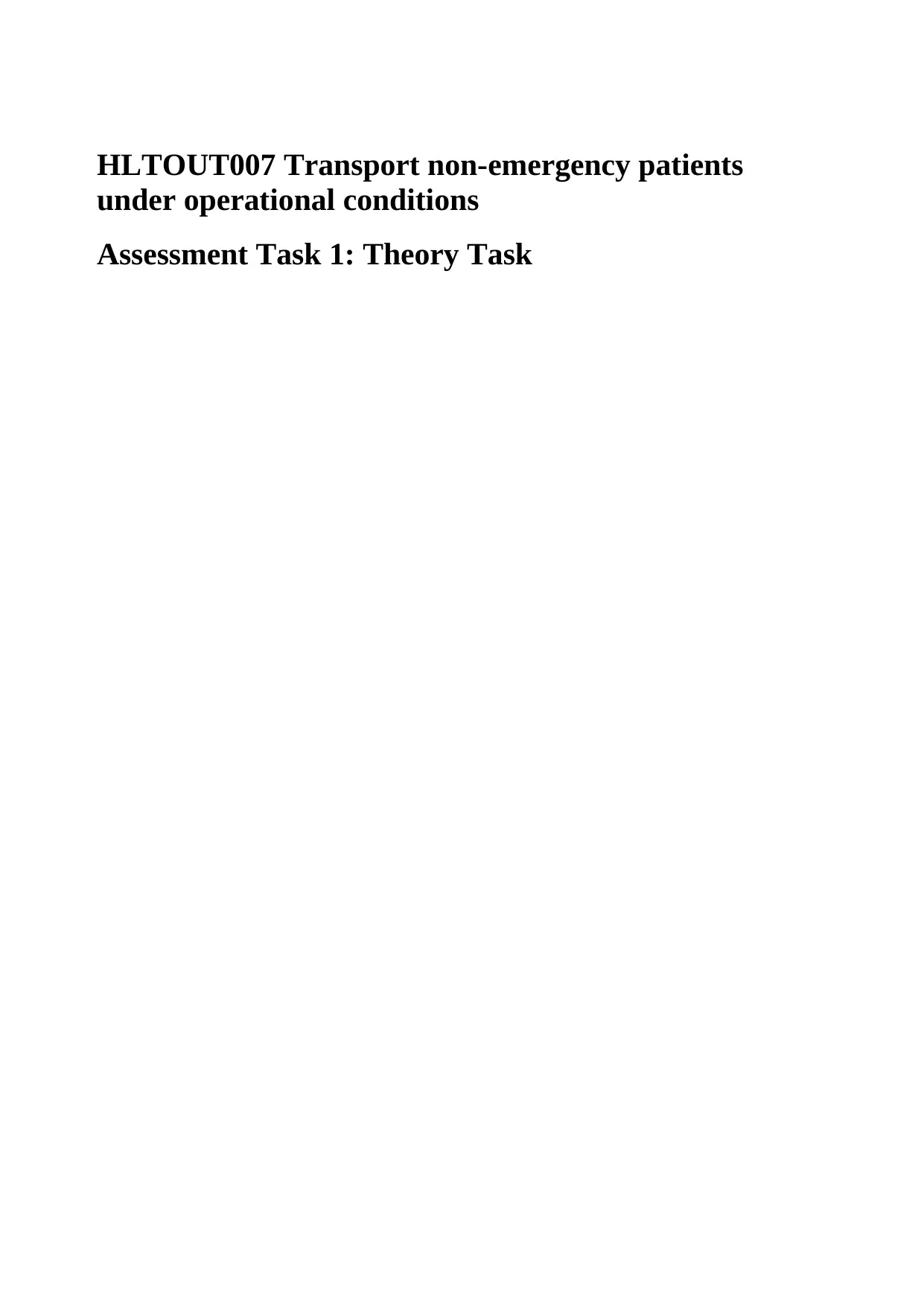
HLTOUT007 Transport non-emergency patients
under operational conditions
Assessment Task 1: Theory Task
under operational conditions
Assessment Task 1: Theory Task
Paraphrase This Document
Need a fresh take? Get an instant paraphrase of this document with our AI Paraphraser
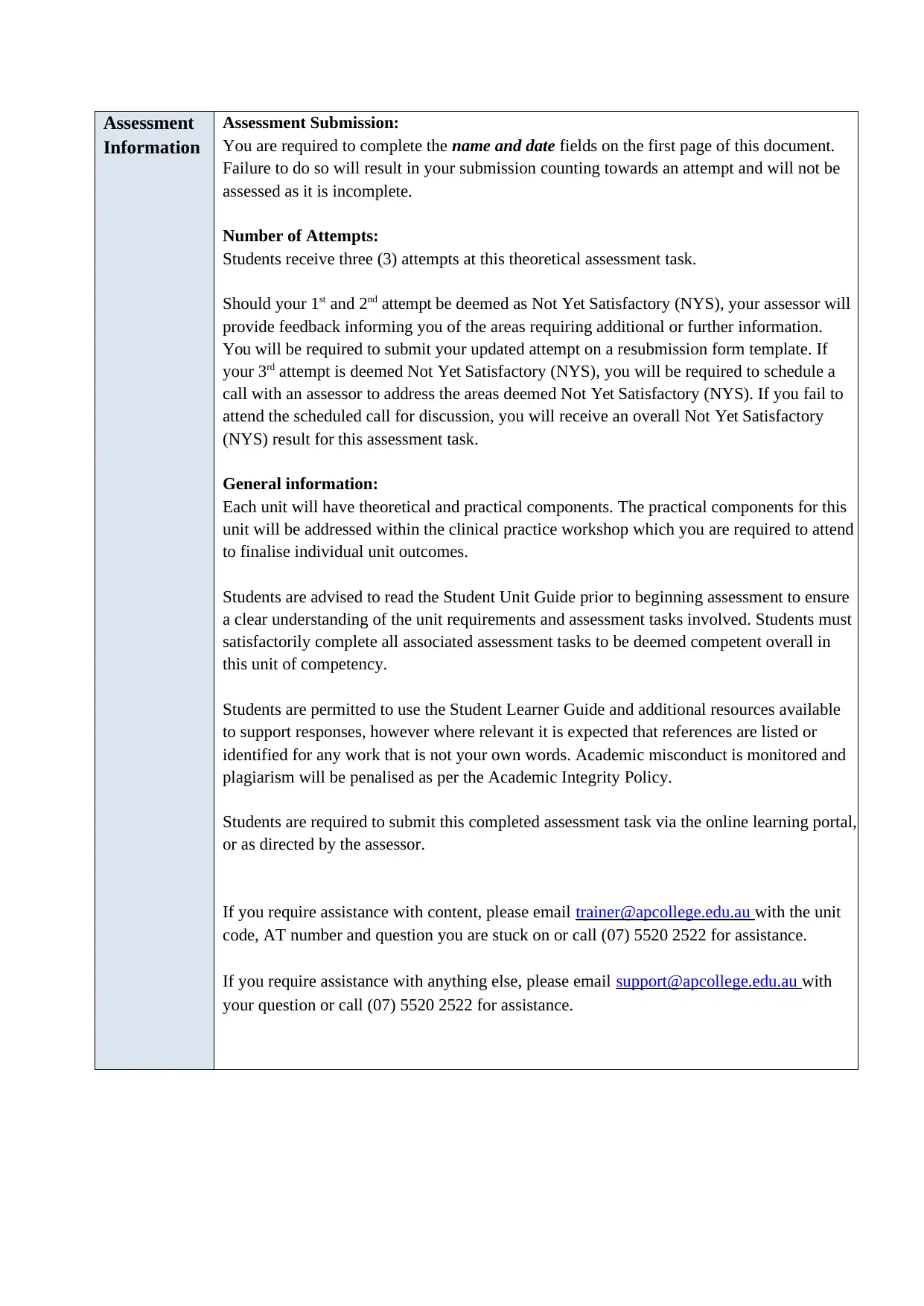
Assessment
Information
Assessment Submission:
You are required to complete the name and date fields on the first page of this document.
Failure to do so will result in your submission counting towards an attempt and will not be
assessed as it is incomplete.
Number of Attempts:
Students receive three (3) attempts at this theoretical assessment task.
Should your 1st and 2nd attempt be deemed as Not Yet Satisfactory (NYS), your assessor will
provide feedback informing you of the areas requiring additional or further information.
You will be required to submit your updated attempt on a resubmission form template. If
your 3rd attempt is deemed Not Yet Satisfactory (NYS), you will be required to schedule a
call with an assessor to address the areas deemed Not Yet Satisfactory (NYS). If you fail to
attend the scheduled call for discussion, you will receive an overall Not Yet Satisfactory
(NYS) result for this assessment task.
General information:
Each unit will have theoretical and practical components. The practical components for this
unit will be addressed within the clinical practice workshop which you are required to attend
to finalise individual unit outcomes.
Students are advised to read the Student Unit Guide prior to beginning assessment to ensure
a clear understanding of the unit requirements and assessment tasks involved. Students must
satisfactorily complete all associated assessment tasks to be deemed competent overall in
this unit of competency.
Students are permitted to use the Student Learner Guide and additional resources available
to support responses, however where relevant it is expected that references are listed or
identified for any work that is not your own words. Academic misconduct is monitored and
plagiarism will be penalised as per the Academic Integrity Policy.
Students are required to submit this completed assessment task via the online learning portal,
or as directed by the assessor.
If you require assistance with content, please email trainer@apcollege.edu.au with the unit
code, AT number and question you are stuck on or call (07) 5520 2522 for assistance.
If you require assistance with anything else, please email support@apcollege.edu.au with
your question or call (07) 5520 2522 for assistance.
Information
Assessment Submission:
You are required to complete the name and date fields on the first page of this document.
Failure to do so will result in your submission counting towards an attempt and will not be
assessed as it is incomplete.
Number of Attempts:
Students receive three (3) attempts at this theoretical assessment task.
Should your 1st and 2nd attempt be deemed as Not Yet Satisfactory (NYS), your assessor will
provide feedback informing you of the areas requiring additional or further information.
You will be required to submit your updated attempt on a resubmission form template. If
your 3rd attempt is deemed Not Yet Satisfactory (NYS), you will be required to schedule a
call with an assessor to address the areas deemed Not Yet Satisfactory (NYS). If you fail to
attend the scheduled call for discussion, you will receive an overall Not Yet Satisfactory
(NYS) result for this assessment task.
General information:
Each unit will have theoretical and practical components. The practical components for this
unit will be addressed within the clinical practice workshop which you are required to attend
to finalise individual unit outcomes.
Students are advised to read the Student Unit Guide prior to beginning assessment to ensure
a clear understanding of the unit requirements and assessment tasks involved. Students must
satisfactorily complete all associated assessment tasks to be deemed competent overall in
this unit of competency.
Students are permitted to use the Student Learner Guide and additional resources available
to support responses, however where relevant it is expected that references are listed or
identified for any work that is not your own words. Academic misconduct is monitored and
plagiarism will be penalised as per the Academic Integrity Policy.
Students are required to submit this completed assessment task via the online learning portal,
or as directed by the assessor.
If you require assistance with content, please email trainer@apcollege.edu.au with the unit
code, AT number and question you are stuck on or call (07) 5520 2522 for assistance.
If you require assistance with anything else, please email support@apcollege.edu.au with
your question or call (07) 5520 2522 for assistance.
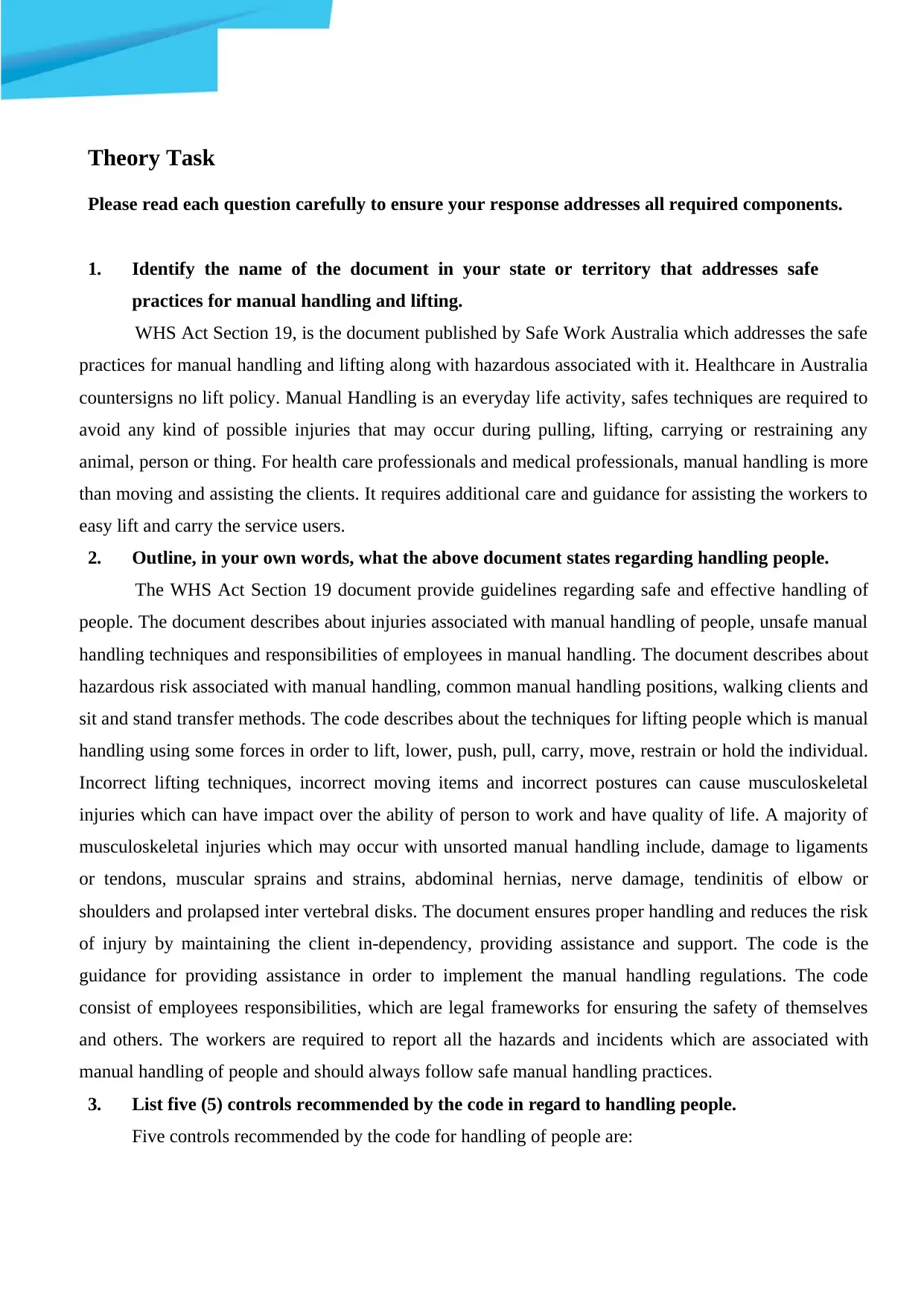
Theory Task
Please read each question carefully to ensure your response addresses all required components.
1. Identify the name of the document in your state or territory that addresses safe
practices for manual handling and lifting.
WHS Act Section 19, is the document published by Safe Work Australia which addresses the safe
practices for manual handling and lifting along with hazardous associated with it. Healthcare in Australia
countersigns no lift policy. Manual Handling is an everyday life activity, safes techniques are required to
avoid any kind of possible injuries that may occur during pulling, lifting, carrying or restraining any
animal, person or thing. For health care professionals and medical professionals, manual handling is more
than moving and assisting the clients. It requires additional care and guidance for assisting the workers to
easy lift and carry the service users.
2. Outline, in your own words, what the above document states regarding handling people.
The WHS Act Section 19 document provide guidelines regarding safe and effective handling of
people. The document describes about injuries associated with manual handling of people, unsafe manual
handling techniques and responsibilities of employees in manual handling. The document describes about
hazardous risk associated with manual handling, common manual handling positions, walking clients and
sit and stand transfer methods. The code describes about the techniques for lifting people which is manual
handling using some forces in order to lift, lower, push, pull, carry, move, restrain or hold the individual.
Incorrect lifting techniques, incorrect moving items and incorrect postures can cause musculoskeletal
injuries which can have impact over the ability of person to work and have quality of life. A majority of
musculoskeletal injuries which may occur with unsorted manual handling include, damage to ligaments
or tendons, muscular sprains and strains, abdominal hernias, nerve damage, tendinitis of elbow or
shoulders and prolapsed inter vertebral disks. The document ensures proper handling and reduces the risk
of injury by maintaining the client in-dependency, providing assistance and support. The code is the
guidance for providing assistance in order to implement the manual handling regulations. The code
consist of employees responsibilities, which are legal frameworks for ensuring the safety of themselves
and others. The workers are required to report all the hazards and incidents which are associated with
manual handling of people and should always follow safe manual handling practices.
3. List five (5) controls recommended by the code in regard to handling people.
Five controls recommended by the code for handling of people are:
Please read each question carefully to ensure your response addresses all required components.
1. Identify the name of the document in your state or territory that addresses safe
practices for manual handling and lifting.
WHS Act Section 19, is the document published by Safe Work Australia which addresses the safe
practices for manual handling and lifting along with hazardous associated with it. Healthcare in Australia
countersigns no lift policy. Manual Handling is an everyday life activity, safes techniques are required to
avoid any kind of possible injuries that may occur during pulling, lifting, carrying or restraining any
animal, person or thing. For health care professionals and medical professionals, manual handling is more
than moving and assisting the clients. It requires additional care and guidance for assisting the workers to
easy lift and carry the service users.
2. Outline, in your own words, what the above document states regarding handling people.
The WHS Act Section 19 document provide guidelines regarding safe and effective handling of
people. The document describes about injuries associated with manual handling of people, unsafe manual
handling techniques and responsibilities of employees in manual handling. The document describes about
hazardous risk associated with manual handling, common manual handling positions, walking clients and
sit and stand transfer methods. The code describes about the techniques for lifting people which is manual
handling using some forces in order to lift, lower, push, pull, carry, move, restrain or hold the individual.
Incorrect lifting techniques, incorrect moving items and incorrect postures can cause musculoskeletal
injuries which can have impact over the ability of person to work and have quality of life. A majority of
musculoskeletal injuries which may occur with unsorted manual handling include, damage to ligaments
or tendons, muscular sprains and strains, abdominal hernias, nerve damage, tendinitis of elbow or
shoulders and prolapsed inter vertebral disks. The document ensures proper handling and reduces the risk
of injury by maintaining the client in-dependency, providing assistance and support. The code is the
guidance for providing assistance in order to implement the manual handling regulations. The code
consist of employees responsibilities, which are legal frameworks for ensuring the safety of themselves
and others. The workers are required to report all the hazards and incidents which are associated with
manual handling of people and should always follow safe manual handling practices.
3. List five (5) controls recommended by the code in regard to handling people.
Five controls recommended by the code for handling of people are:
⊘ This is a preview!⊘
Do you want full access?
Subscribe today to unlock all pages.

Trusted by 1+ million students worldwide
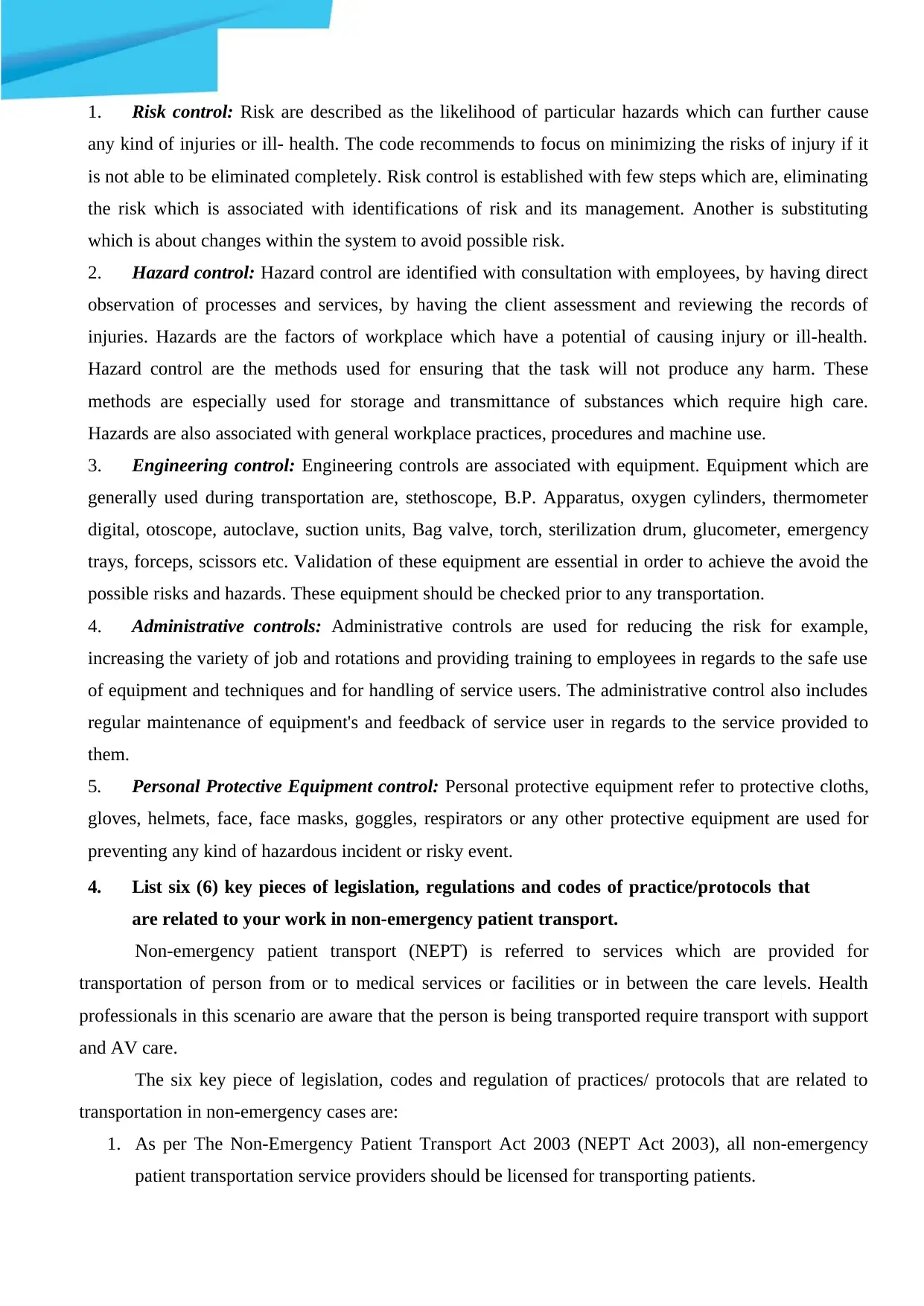
1. Risk control: Risk are described as the likelihood of particular hazards which can further cause
any kind of injuries or ill- health. The code recommends to focus on minimizing the risks of injury if it
is not able to be eliminated completely. Risk control is established with few steps which are, eliminating
the risk which is associated with identifications of risk and its management. Another is substituting
which is about changes within the system to avoid possible risk.
2. Hazard control: Hazard control are identified with consultation with employees, by having direct
observation of processes and services, by having the client assessment and reviewing the records of
injuries. Hazards are the factors of workplace which have a potential of causing injury or ill-health.
Hazard control are the methods used for ensuring that the task will not produce any harm. These
methods are especially used for storage and transmittance of substances which require high care.
Hazards are also associated with general workplace practices, procedures and machine use.
3. Engineering control: Engineering controls are associated with equipment. Equipment which are
generally used during transportation are, stethoscope, B.P. Apparatus, oxygen cylinders, thermometer
digital, otoscope, autoclave, suction units, Bag valve, torch, sterilization drum, glucometer, emergency
trays, forceps, scissors etc. Validation of these equipment are essential in order to achieve the avoid the
possible risks and hazards. These equipment should be checked prior to any transportation.
4. Administrative controls: Administrative controls are used for reducing the risk for example,
increasing the variety of job and rotations and providing training to employees in regards to the safe use
of equipment and techniques and for handling of service users. The administrative control also includes
regular maintenance of equipment's and feedback of service user in regards to the service provided to
them.
5. Personal Protective Equipment control: Personal protective equipment refer to protective cloths,
gloves, helmets, face, face masks, goggles, respirators or any other protective equipment are used for
preventing any kind of hazardous incident or risky event.
4. List six (6) key pieces of legislation, regulations and codes of practice/protocols that
are related to your work in non-emergency patient transport.
Non-emergency patient transport (NEPT) is referred to services which are provided for
transportation of person from or to medical services or facilities or in between the care levels. Health
professionals in this scenario are aware that the person is being transported require transport with support
and AV care.
The six key piece of legislation, codes and regulation of practices/ protocols that are related to
transportation in non-emergency cases are:
1. As per The Non-Emergency Patient Transport Act 2003 (NEPT Act 2003), all non-emergency
patient transportation service providers should be licensed for transporting patients.
any kind of injuries or ill- health. The code recommends to focus on minimizing the risks of injury if it
is not able to be eliminated completely. Risk control is established with few steps which are, eliminating
the risk which is associated with identifications of risk and its management. Another is substituting
which is about changes within the system to avoid possible risk.
2. Hazard control: Hazard control are identified with consultation with employees, by having direct
observation of processes and services, by having the client assessment and reviewing the records of
injuries. Hazards are the factors of workplace which have a potential of causing injury or ill-health.
Hazard control are the methods used for ensuring that the task will not produce any harm. These
methods are especially used for storage and transmittance of substances which require high care.
Hazards are also associated with general workplace practices, procedures and machine use.
3. Engineering control: Engineering controls are associated with equipment. Equipment which are
generally used during transportation are, stethoscope, B.P. Apparatus, oxygen cylinders, thermometer
digital, otoscope, autoclave, suction units, Bag valve, torch, sterilization drum, glucometer, emergency
trays, forceps, scissors etc. Validation of these equipment are essential in order to achieve the avoid the
possible risks and hazards. These equipment should be checked prior to any transportation.
4. Administrative controls: Administrative controls are used for reducing the risk for example,
increasing the variety of job and rotations and providing training to employees in regards to the safe use
of equipment and techniques and for handling of service users. The administrative control also includes
regular maintenance of equipment's and feedback of service user in regards to the service provided to
them.
5. Personal Protective Equipment control: Personal protective equipment refer to protective cloths,
gloves, helmets, face, face masks, goggles, respirators or any other protective equipment are used for
preventing any kind of hazardous incident or risky event.
4. List six (6) key pieces of legislation, regulations and codes of practice/protocols that
are related to your work in non-emergency patient transport.
Non-emergency patient transport (NEPT) is referred to services which are provided for
transportation of person from or to medical services or facilities or in between the care levels. Health
professionals in this scenario are aware that the person is being transported require transport with support
and AV care.
The six key piece of legislation, codes and regulation of practices/ protocols that are related to
transportation in non-emergency cases are:
1. As per The Non-Emergency Patient Transport Act 2003 (NEPT Act 2003), all non-emergency
patient transportation service providers should be licensed for transporting patients.
Paraphrase This Document
Need a fresh take? Get an instant paraphrase of this document with our AI Paraphraser
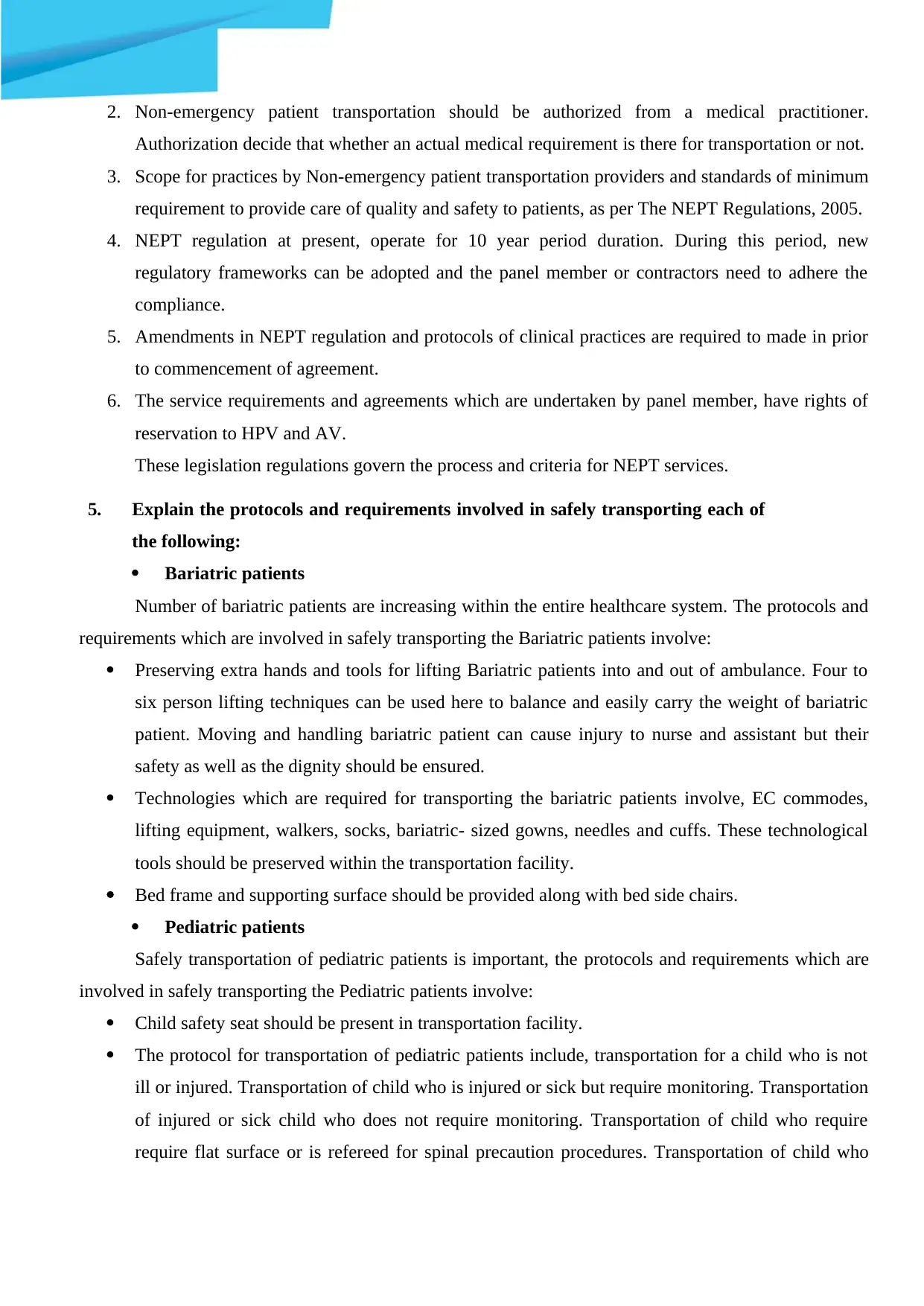
2. Non-emergency patient transportation should be authorized from a medical practitioner.
Authorization decide that whether an actual medical requirement is there for transportation or not.
3. Scope for practices by Non-emergency patient transportation providers and standards of minimum
requirement to provide care of quality and safety to patients, as per The NEPT Regulations, 2005.
4. NEPT regulation at present, operate for 10 year period duration. During this period, new
regulatory frameworks can be adopted and the panel member or contractors need to adhere the
compliance.
5. Amendments in NEPT regulation and protocols of clinical practices are required to made in prior
to commencement of agreement.
6. The service requirements and agreements which are undertaken by panel member, have rights of
reservation to HPV and AV.
These legislation regulations govern the process and criteria for NEPT services.
5. Explain the protocols and requirements involved in safely transporting each of
the following:
Bariatric patients
Number of bariatric patients are increasing within the entire healthcare system. The protocols and
requirements which are involved in safely transporting the Bariatric patients involve:
Preserving extra hands and tools for lifting Bariatric patients into and out of ambulance. Four to
six person lifting techniques can be used here to balance and easily carry the weight of bariatric
patient. Moving and handling bariatric patient can cause injury to nurse and assistant but their
safety as well as the dignity should be ensured.
Technologies which are required for transporting the bariatric patients involve, EC commodes,
lifting equipment, walkers, socks, bariatric- sized gowns, needles and cuffs. These technological
tools should be preserved within the transportation facility.
Bed frame and supporting surface should be provided along with bed side chairs.
Pediatric patients
Safely transportation of pediatric patients is important, the protocols and requirements which are
involved in safely transporting the Pediatric patients involve:
Child safety seat should be present in transportation facility.
The protocol for transportation of pediatric patients include, transportation for a child who is not
ill or injured. Transportation of child who is injured or sick but require monitoring. Transportation
of injured or sick child who does not require monitoring. Transportation of child who require
require flat surface or is refereed for spinal precaution procedures. Transportation of child who
Authorization decide that whether an actual medical requirement is there for transportation or not.
3. Scope for practices by Non-emergency patient transportation providers and standards of minimum
requirement to provide care of quality and safety to patients, as per The NEPT Regulations, 2005.
4. NEPT regulation at present, operate for 10 year period duration. During this period, new
regulatory frameworks can be adopted and the panel member or contractors need to adhere the
compliance.
5. Amendments in NEPT regulation and protocols of clinical practices are required to made in prior
to commencement of agreement.
6. The service requirements and agreements which are undertaken by panel member, have rights of
reservation to HPV and AV.
These legislation regulations govern the process and criteria for NEPT services.
5. Explain the protocols and requirements involved in safely transporting each of
the following:
Bariatric patients
Number of bariatric patients are increasing within the entire healthcare system. The protocols and
requirements which are involved in safely transporting the Bariatric patients involve:
Preserving extra hands and tools for lifting Bariatric patients into and out of ambulance. Four to
six person lifting techniques can be used here to balance and easily carry the weight of bariatric
patient. Moving and handling bariatric patient can cause injury to nurse and assistant but their
safety as well as the dignity should be ensured.
Technologies which are required for transporting the bariatric patients involve, EC commodes,
lifting equipment, walkers, socks, bariatric- sized gowns, needles and cuffs. These technological
tools should be preserved within the transportation facility.
Bed frame and supporting surface should be provided along with bed side chairs.
Pediatric patients
Safely transportation of pediatric patients is important, the protocols and requirements which are
involved in safely transporting the Pediatric patients involve:
Child safety seat should be present in transportation facility.
The protocol for transportation of pediatric patients include, transportation for a child who is not
ill or injured. Transportation of child who is injured or sick but require monitoring. Transportation
of injured or sick child who does not require monitoring. Transportation of child who require
require flat surface or is refereed for spinal precaution procedures. Transportation of child who
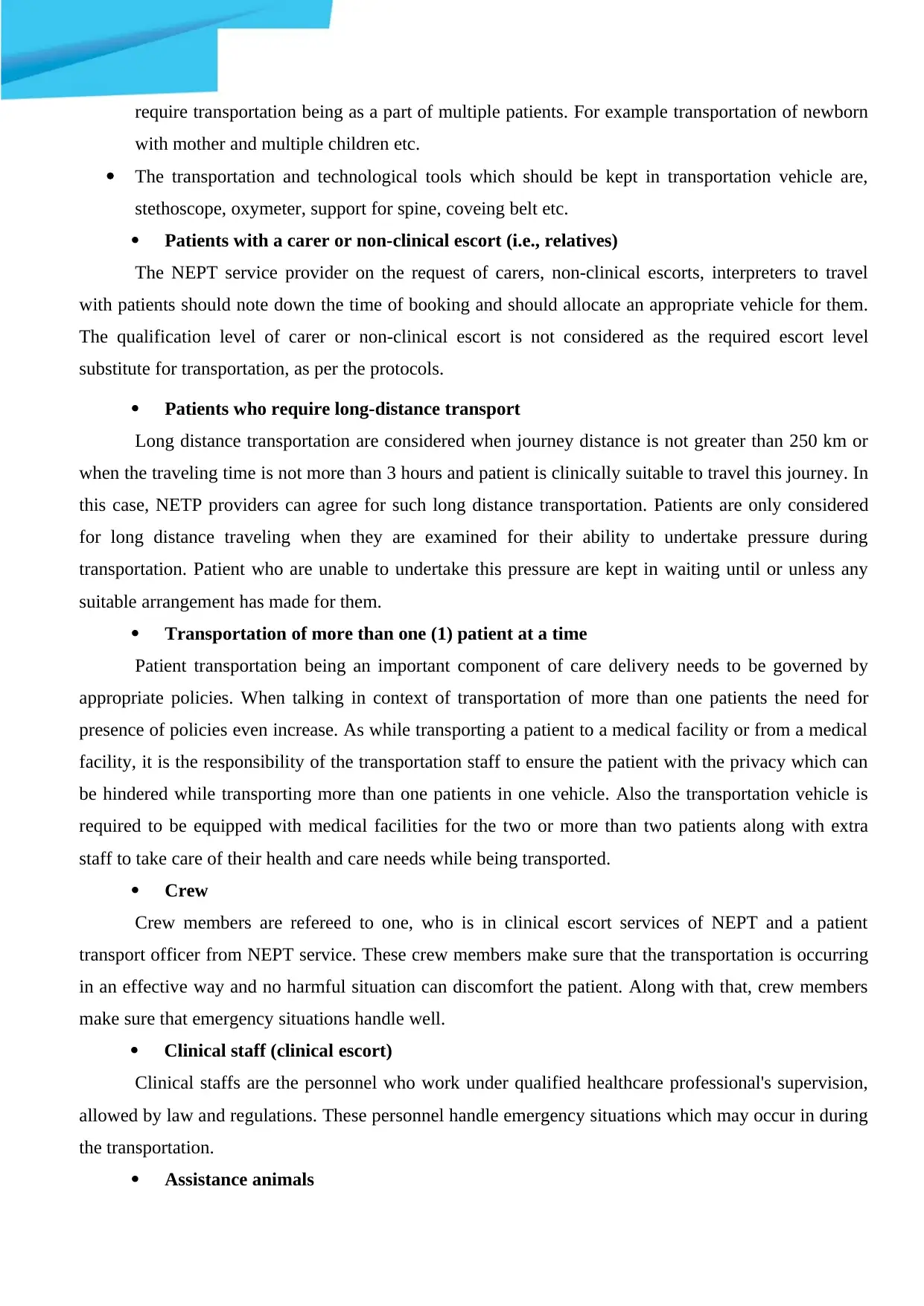
require transportation being as a part of multiple patients. For example transportation of newborn
with mother and multiple children etc.
The transportation and technological tools which should be kept in transportation vehicle are,
stethoscope, oxymeter, support for spine, coveing belt etc.
Patients with a carer or non-clinical escort (i.e., relatives)
The NEPT service provider on the request of carers, non-clinical escorts, interpreters to travel
with patients should note down the time of booking and should allocate an appropriate vehicle for them.
The qualification level of carer or non-clinical escort is not considered as the required escort level
substitute for transportation, as per the protocols.
Patients who require long-distance transport
Long distance transportation are considered when journey distance is not greater than 250 km or
when the traveling time is not more than 3 hours and patient is clinically suitable to travel this journey. In
this case, NETP providers can agree for such long distance transportation. Patients are only considered
for long distance traveling when they are examined for their ability to undertake pressure during
transportation. Patient who are unable to undertake this pressure are kept in waiting until or unless any
suitable arrangement has made for them.
Transportation of more than one (1) patient at a time
Patient transportation being an important component of care delivery needs to be governed by
appropriate policies. When talking in context of transportation of more than one patients the need for
presence of policies even increase. As while transporting a patient to a medical facility or from a medical
facility, it is the responsibility of the transportation staff to ensure the patient with the privacy which can
be hindered while transporting more than one patients in one vehicle. Also the transportation vehicle is
required to be equipped with medical facilities for the two or more than two patients along with extra
staff to take care of their health and care needs while being transported.
Crew
Crew members are refereed to one, who is in clinical escort services of NEPT and a patient
transport officer from NEPT service. These crew members make sure that the transportation is occurring
in an effective way and no harmful situation can discomfort the patient. Along with that, crew members
make sure that emergency situations handle well.
Clinical staff (clinical escort)
Clinical staffs are the personnel who work under qualified healthcare professional's supervision,
allowed by law and regulations. These personnel handle emergency situations which may occur in during
the transportation.
Assistance animals
with mother and multiple children etc.
The transportation and technological tools which should be kept in transportation vehicle are,
stethoscope, oxymeter, support for spine, coveing belt etc.
Patients with a carer or non-clinical escort (i.e., relatives)
The NEPT service provider on the request of carers, non-clinical escorts, interpreters to travel
with patients should note down the time of booking and should allocate an appropriate vehicle for them.
The qualification level of carer or non-clinical escort is not considered as the required escort level
substitute for transportation, as per the protocols.
Patients who require long-distance transport
Long distance transportation are considered when journey distance is not greater than 250 km or
when the traveling time is not more than 3 hours and patient is clinically suitable to travel this journey. In
this case, NETP providers can agree for such long distance transportation. Patients are only considered
for long distance traveling when they are examined for their ability to undertake pressure during
transportation. Patient who are unable to undertake this pressure are kept in waiting until or unless any
suitable arrangement has made for them.
Transportation of more than one (1) patient at a time
Patient transportation being an important component of care delivery needs to be governed by
appropriate policies. When talking in context of transportation of more than one patients the need for
presence of policies even increase. As while transporting a patient to a medical facility or from a medical
facility, it is the responsibility of the transportation staff to ensure the patient with the privacy which can
be hindered while transporting more than one patients in one vehicle. Also the transportation vehicle is
required to be equipped with medical facilities for the two or more than two patients along with extra
staff to take care of their health and care needs while being transported.
Crew
Crew members are refereed to one, who is in clinical escort services of NEPT and a patient
transport officer from NEPT service. These crew members make sure that the transportation is occurring
in an effective way and no harmful situation can discomfort the patient. Along with that, crew members
make sure that emergency situations handle well.
Clinical staff (clinical escort)
Clinical staffs are the personnel who work under qualified healthcare professional's supervision,
allowed by law and regulations. These personnel handle emergency situations which may occur in during
the transportation.
Assistance animals
⊘ This is a preview!⊘
Do you want full access?
Subscribe today to unlock all pages.

Trusted by 1+ million students worldwide
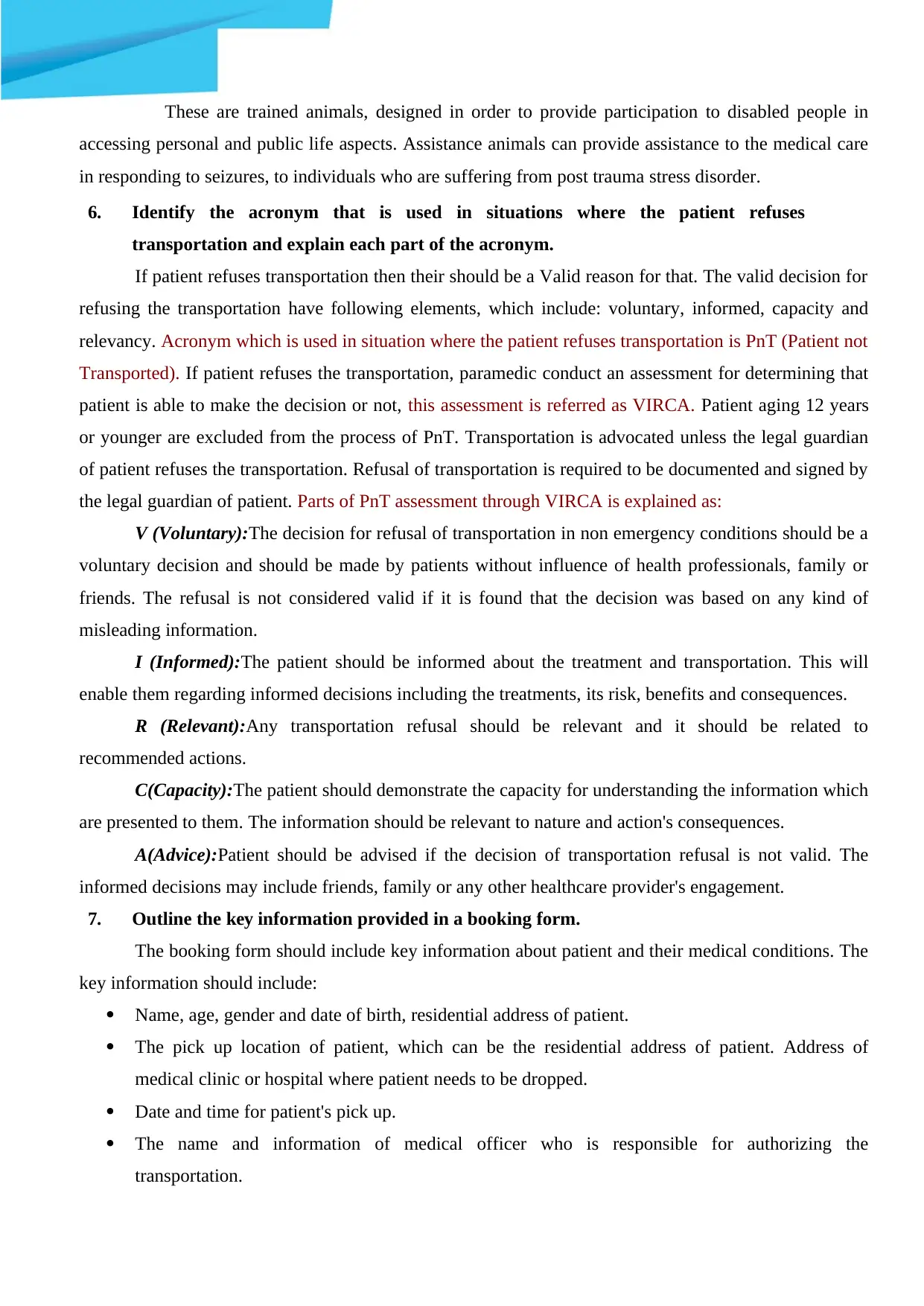
These are trained animals, designed in order to provide participation to disabled people in
accessing personal and public life aspects. Assistance animals can provide assistance to the medical care
in responding to seizures, to individuals who are suffering from post trauma stress disorder.
6. Identify the acronym that is used in situations where the patient refuses
transportation and explain each part of the acronym.
If patient refuses transportation then their should be a Valid reason for that. The valid decision for
refusing the transportation have following elements, which include: voluntary, informed, capacity and
relevancy. Acronym which is used in situation where the patient refuses transportation is PnT (Patient not
Transported). If patient refuses the transportation, paramedic conduct an assessment for determining that
patient is able to make the decision or not, this assessment is referred as VIRCA. Patient aging 12 years
or younger are excluded from the process of PnT. Transportation is advocated unless the legal guardian
of patient refuses the transportation. Refusal of transportation is required to be documented and signed by
the legal guardian of patient. Parts of PnT assessment through VIRCA is explained as:
V (Voluntary):The decision for refusal of transportation in non emergency conditions should be a
voluntary decision and should be made by patients without influence of health professionals, family or
friends. The refusal is not considered valid if it is found that the decision was based on any kind of
misleading information.
I (Informed):The patient should be informed about the treatment and transportation. This will
enable them regarding informed decisions including the treatments, its risk, benefits and consequences.
R (Relevant):Any transportation refusal should be relevant and it should be related to
recommended actions.
C(Capacity):The patient should demonstrate the capacity for understanding the information which
are presented to them. The information should be relevant to nature and action's consequences.
A(Advice):Patient should be advised if the decision of transportation refusal is not valid. The
informed decisions may include friends, family or any other healthcare provider's engagement.
7. Outline the key information provided in a booking form.
The booking form should include key information about patient and their medical conditions. The
key information should include:
Name, age, gender and date of birth, residential address of patient.
The pick up location of patient, which can be the residential address of patient. Address of
medical clinic or hospital where patient needs to be dropped.
Date and time for patient's pick up.
The name and information of medical officer who is responsible for authorizing the
transportation.
accessing personal and public life aspects. Assistance animals can provide assistance to the medical care
in responding to seizures, to individuals who are suffering from post trauma stress disorder.
6. Identify the acronym that is used in situations where the patient refuses
transportation and explain each part of the acronym.
If patient refuses transportation then their should be a Valid reason for that. The valid decision for
refusing the transportation have following elements, which include: voluntary, informed, capacity and
relevancy. Acronym which is used in situation where the patient refuses transportation is PnT (Patient not
Transported). If patient refuses the transportation, paramedic conduct an assessment for determining that
patient is able to make the decision or not, this assessment is referred as VIRCA. Patient aging 12 years
or younger are excluded from the process of PnT. Transportation is advocated unless the legal guardian
of patient refuses the transportation. Refusal of transportation is required to be documented and signed by
the legal guardian of patient. Parts of PnT assessment through VIRCA is explained as:
V (Voluntary):The decision for refusal of transportation in non emergency conditions should be a
voluntary decision and should be made by patients without influence of health professionals, family or
friends. The refusal is not considered valid if it is found that the decision was based on any kind of
misleading information.
I (Informed):The patient should be informed about the treatment and transportation. This will
enable them regarding informed decisions including the treatments, its risk, benefits and consequences.
R (Relevant):Any transportation refusal should be relevant and it should be related to
recommended actions.
C(Capacity):The patient should demonstrate the capacity for understanding the information which
are presented to them. The information should be relevant to nature and action's consequences.
A(Advice):Patient should be advised if the decision of transportation refusal is not valid. The
informed decisions may include friends, family or any other healthcare provider's engagement.
7. Outline the key information provided in a booking form.
The booking form should include key information about patient and their medical conditions. The
key information should include:
Name, age, gender and date of birth, residential address of patient.
The pick up location of patient, which can be the residential address of patient. Address of
medical clinic or hospital where patient needs to be dropped.
Date and time for patient's pick up.
The name and information of medical officer who is responsible for authorizing the
transportation.
Paraphrase This Document
Need a fresh take? Get an instant paraphrase of this document with our AI Paraphraser
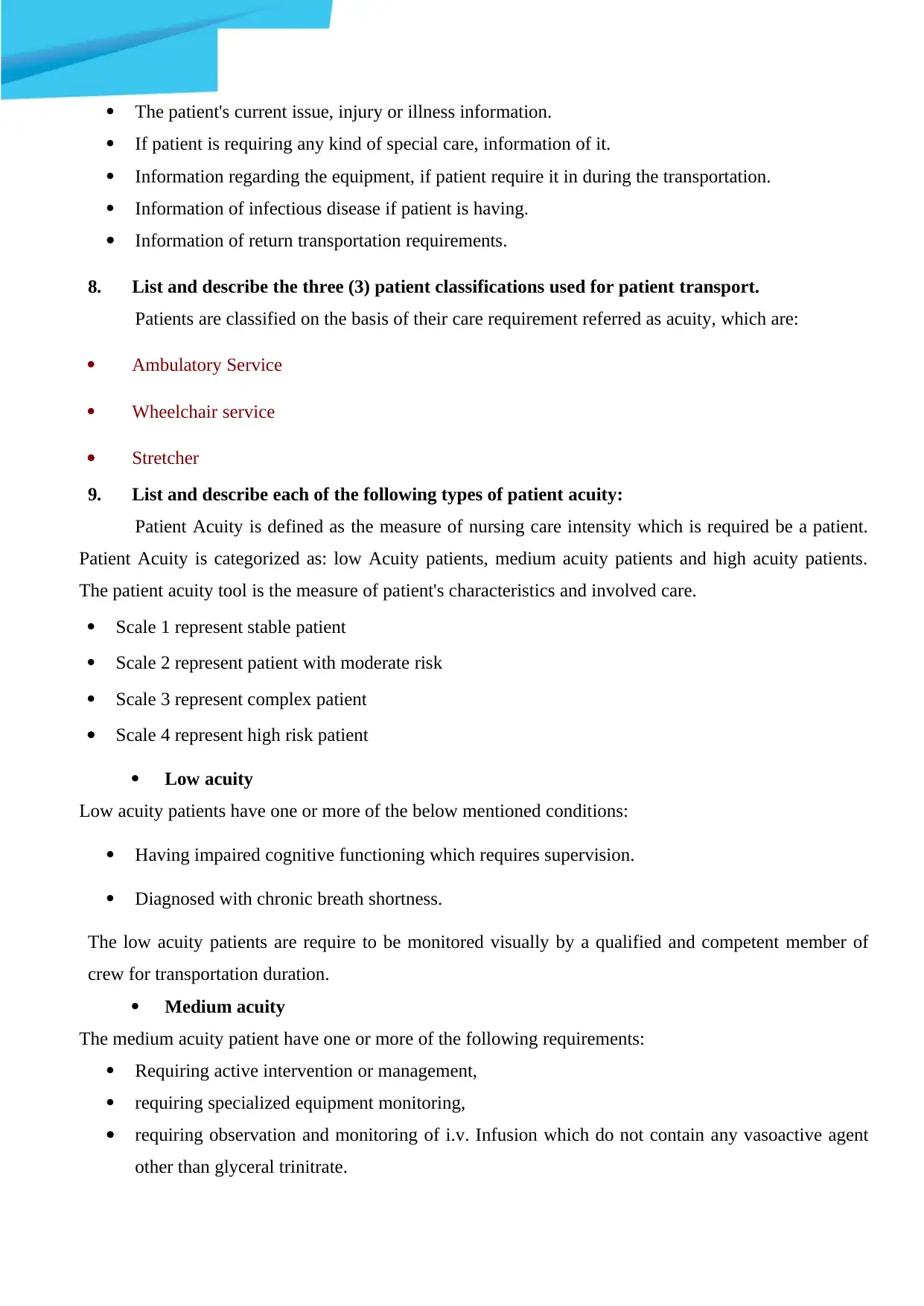
The patient's current issue, injury or illness information.
If patient is requiring any kind of special care, information of it.
Information regarding the equipment, if patient require it in during the transportation.
Information of infectious disease if patient is having.
Information of return transportation requirements.
8. List and describe the three (3) patient classifications used for patient transport.
Patients are classified on the basis of their care requirement referred as acuity, which are:
Ambulatory Service
Wheelchair service
Stretcher
9. List and describe each of the following types of patient acuity:
Patient Acuity is defined as the measure of nursing care intensity which is required be a patient.
Patient Acuity is categorized as: low Acuity patients, medium acuity patients and high acuity patients.
The patient acuity tool is the measure of patient's characteristics and involved care.
Scale 1 represent stable patient
Scale 2 represent patient with moderate risk
Scale 3 represent complex patient
Scale 4 represent high risk patient
Low acuity
Low acuity patients have one or more of the below mentioned conditions:
Having impaired cognitive functioning which requires supervision.
Diagnosed with chronic breath shortness.
The low acuity patients are require to be monitored visually by a qualified and competent member of
crew for transportation duration.
Medium acuity
The medium acuity patient have one or more of the following requirements:
Requiring active intervention or management,
requiring specialized equipment monitoring,
requiring observation and monitoring of i.v. Infusion which do not contain any vasoactive agent
other than glyceral trinitrate.
If patient is requiring any kind of special care, information of it.
Information regarding the equipment, if patient require it in during the transportation.
Information of infectious disease if patient is having.
Information of return transportation requirements.
8. List and describe the three (3) patient classifications used for patient transport.
Patients are classified on the basis of their care requirement referred as acuity, which are:
Ambulatory Service
Wheelchair service
Stretcher
9. List and describe each of the following types of patient acuity:
Patient Acuity is defined as the measure of nursing care intensity which is required be a patient.
Patient Acuity is categorized as: low Acuity patients, medium acuity patients and high acuity patients.
The patient acuity tool is the measure of patient's characteristics and involved care.
Scale 1 represent stable patient
Scale 2 represent patient with moderate risk
Scale 3 represent complex patient
Scale 4 represent high risk patient
Low acuity
Low acuity patients have one or more of the below mentioned conditions:
Having impaired cognitive functioning which requires supervision.
Diagnosed with chronic breath shortness.
The low acuity patients are require to be monitored visually by a qualified and competent member of
crew for transportation duration.
Medium acuity
The medium acuity patient have one or more of the following requirements:
Requiring active intervention or management,
requiring specialized equipment monitoring,
requiring observation and monitoring of i.v. Infusion which do not contain any vasoactive agent
other than glyceral trinitrate.
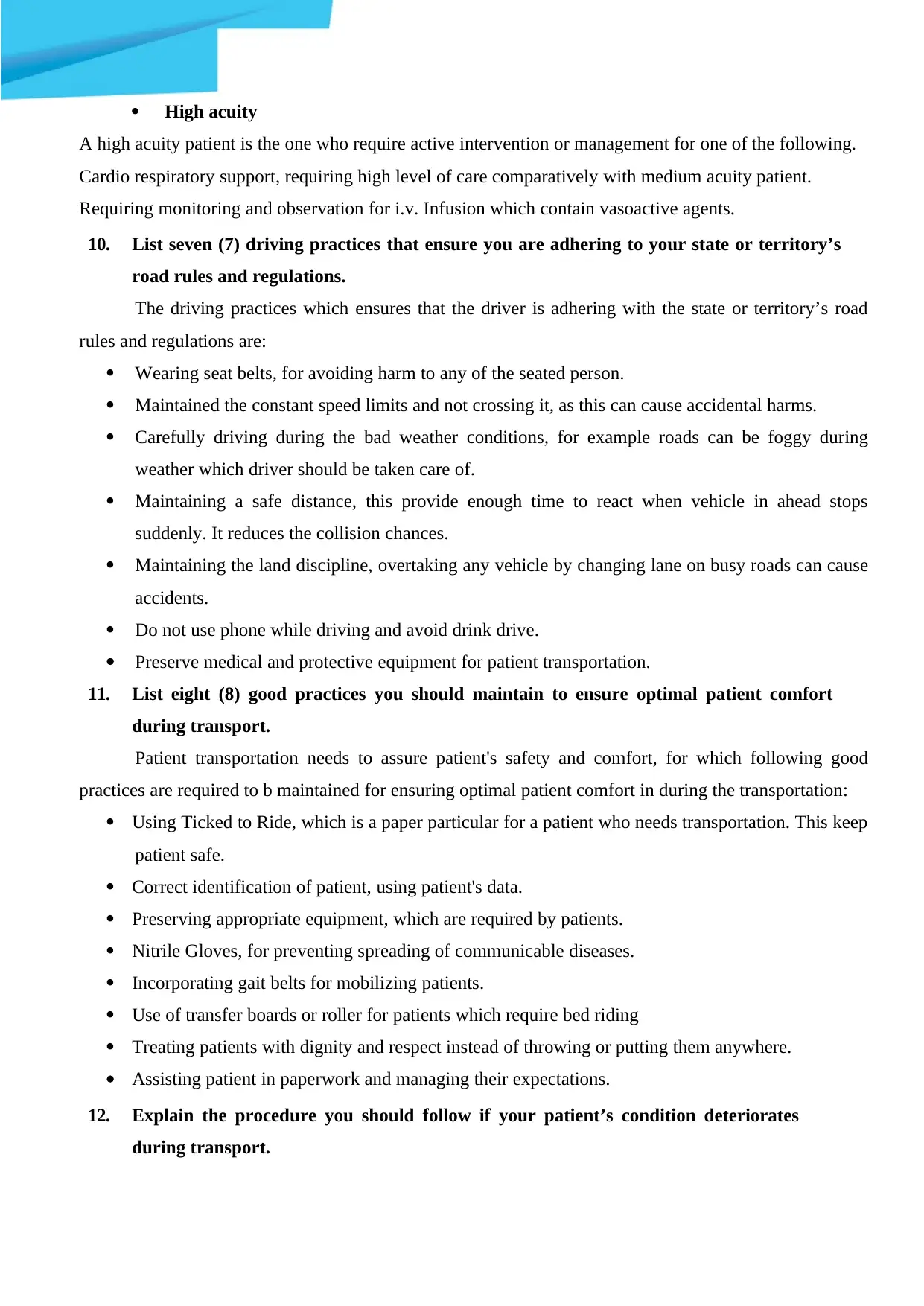
High acuity
A high acuity patient is the one who require active intervention or management for one of the following.
Cardio respiratory support, requiring high level of care comparatively with medium acuity patient.
Requiring monitoring and observation for i.v. Infusion which contain vasoactive agents.
10. List seven (7) driving practices that ensure you are adhering to your state or territory’s
road rules and regulations.
The driving practices which ensures that the driver is adhering with the state or territory’s road
rules and regulations are:
Wearing seat belts, for avoiding harm to any of the seated person.
Maintained the constant speed limits and not crossing it, as this can cause accidental harms.
Carefully driving during the bad weather conditions, for example roads can be foggy during
weather which driver should be taken care of.
Maintaining a safe distance, this provide enough time to react when vehicle in ahead stops
suddenly. It reduces the collision chances.
Maintaining the land discipline, overtaking any vehicle by changing lane on busy roads can cause
accidents.
Do not use phone while driving and avoid drink drive.
Preserve medical and protective equipment for patient transportation.
11. List eight (8) good practices you should maintain to ensure optimal patient comfort
during transport.
Patient transportation needs to assure patient's safety and comfort, for which following good
practices are required to b maintained for ensuring optimal patient comfort in during the transportation:
Using Ticked to Ride, which is a paper particular for a patient who needs transportation. This keep
patient safe.
Correct identification of patient, using patient's data.
Preserving appropriate equipment, which are required by patients.
Nitrile Gloves, for preventing spreading of communicable diseases.
Incorporating gait belts for mobilizing patients.
Use of transfer boards or roller for patients which require bed riding
Treating patients with dignity and respect instead of throwing or putting them anywhere.
Assisting patient in paperwork and managing their expectations.
12. Explain the procedure you should follow if your patient’s condition deteriorates
during transport.
A high acuity patient is the one who require active intervention or management for one of the following.
Cardio respiratory support, requiring high level of care comparatively with medium acuity patient.
Requiring monitoring and observation for i.v. Infusion which contain vasoactive agents.
10. List seven (7) driving practices that ensure you are adhering to your state or territory’s
road rules and regulations.
The driving practices which ensures that the driver is adhering with the state or territory’s road
rules and regulations are:
Wearing seat belts, for avoiding harm to any of the seated person.
Maintained the constant speed limits and not crossing it, as this can cause accidental harms.
Carefully driving during the bad weather conditions, for example roads can be foggy during
weather which driver should be taken care of.
Maintaining a safe distance, this provide enough time to react when vehicle in ahead stops
suddenly. It reduces the collision chances.
Maintaining the land discipline, overtaking any vehicle by changing lane on busy roads can cause
accidents.
Do not use phone while driving and avoid drink drive.
Preserve medical and protective equipment for patient transportation.
11. List eight (8) good practices you should maintain to ensure optimal patient comfort
during transport.
Patient transportation needs to assure patient's safety and comfort, for which following good
practices are required to b maintained for ensuring optimal patient comfort in during the transportation:
Using Ticked to Ride, which is a paper particular for a patient who needs transportation. This keep
patient safe.
Correct identification of patient, using patient's data.
Preserving appropriate equipment, which are required by patients.
Nitrile Gloves, for preventing spreading of communicable diseases.
Incorporating gait belts for mobilizing patients.
Use of transfer boards or roller for patients which require bed riding
Treating patients with dignity and respect instead of throwing or putting them anywhere.
Assisting patient in paperwork and managing their expectations.
12. Explain the procedure you should follow if your patient’s condition deteriorates
during transport.
⊘ This is a preview!⊘
Do you want full access?
Subscribe today to unlock all pages.

Trusted by 1+ million students worldwide
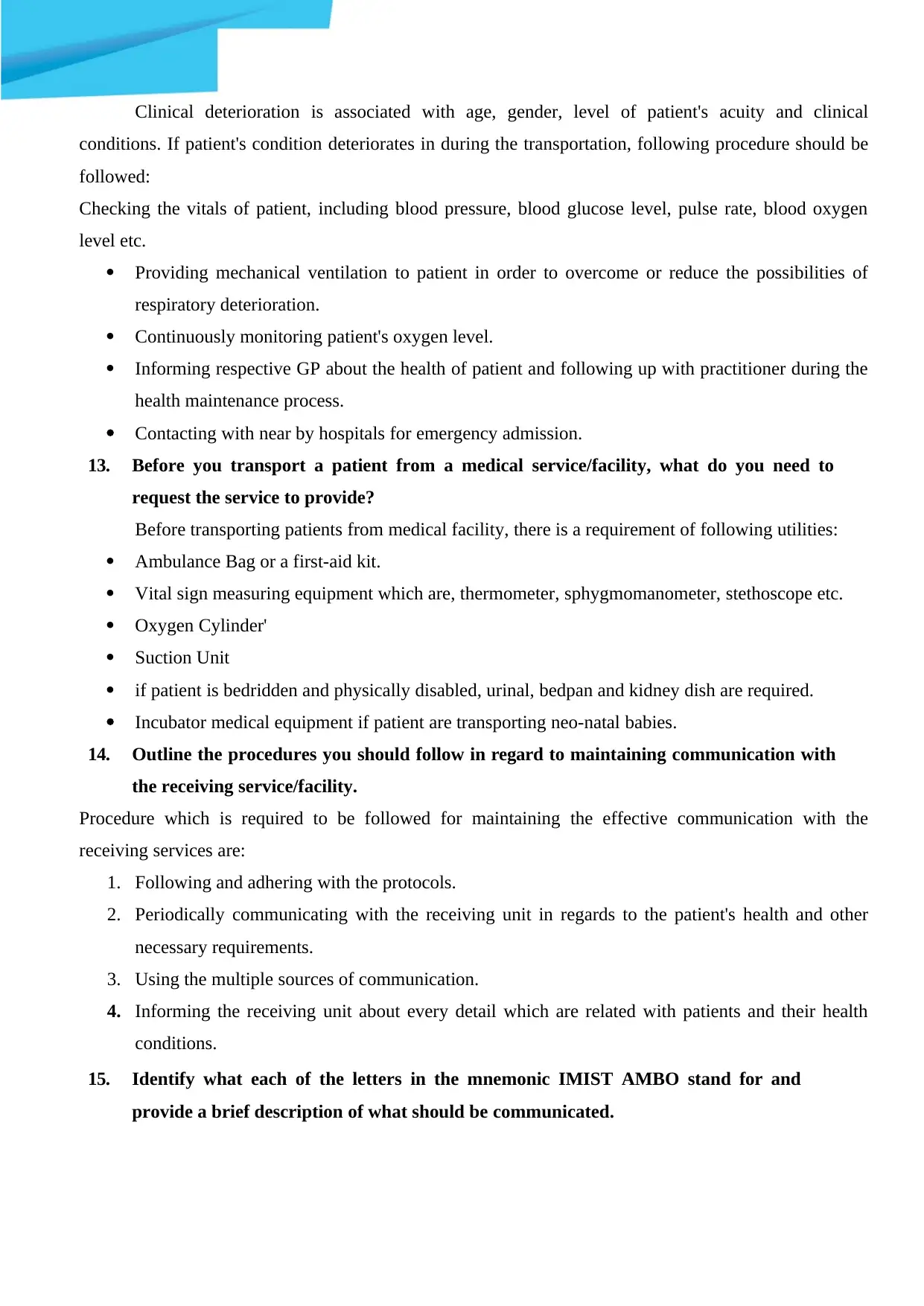
Clinical deterioration is associated with age, gender, level of patient's acuity and clinical
conditions. If patient's condition deteriorates in during the transportation, following procedure should be
followed:
Checking the vitals of patient, including blood pressure, blood glucose level, pulse rate, blood oxygen
level etc.
Providing mechanical ventilation to patient in order to overcome or reduce the possibilities of
respiratory deterioration.
Continuously monitoring patient's oxygen level.
Informing respective GP about the health of patient and following up with practitioner during the
health maintenance process.
Contacting with near by hospitals for emergency admission.
13. Before you transport a patient from a medical service/facility, what do you need to
request the service to provide?
Before transporting patients from medical facility, there is a requirement of following utilities:
Ambulance Bag or a first-aid kit.
Vital sign measuring equipment which are, thermometer, sphygmomanometer, stethoscope etc.
Oxygen Cylinder'
Suction Unit
if patient is bedridden and physically disabled, urinal, bedpan and kidney dish are required.
Incubator medical equipment if patient are transporting neo-natal babies.
14. Outline the procedures you should follow in regard to maintaining communication with
the receiving service/facility.
Procedure which is required to be followed for maintaining the effective communication with the
receiving services are:
1. Following and adhering with the protocols.
2. Periodically communicating with the receiving unit in regards to the patient's health and other
necessary requirements.
3. Using the multiple sources of communication.
4. Informing the receiving unit about every detail which are related with patients and their health
conditions.
15. Identify what each of the letters in the mnemonic IMIST AMBO stand for and
provide a brief description of what should be communicated.
conditions. If patient's condition deteriorates in during the transportation, following procedure should be
followed:
Checking the vitals of patient, including blood pressure, blood glucose level, pulse rate, blood oxygen
level etc.
Providing mechanical ventilation to patient in order to overcome or reduce the possibilities of
respiratory deterioration.
Continuously monitoring patient's oxygen level.
Informing respective GP about the health of patient and following up with practitioner during the
health maintenance process.
Contacting with near by hospitals for emergency admission.
13. Before you transport a patient from a medical service/facility, what do you need to
request the service to provide?
Before transporting patients from medical facility, there is a requirement of following utilities:
Ambulance Bag or a first-aid kit.
Vital sign measuring equipment which are, thermometer, sphygmomanometer, stethoscope etc.
Oxygen Cylinder'
Suction Unit
if patient is bedridden and physically disabled, urinal, bedpan and kidney dish are required.
Incubator medical equipment if patient are transporting neo-natal babies.
14. Outline the procedures you should follow in regard to maintaining communication with
the receiving service/facility.
Procedure which is required to be followed for maintaining the effective communication with the
receiving services are:
1. Following and adhering with the protocols.
2. Periodically communicating with the receiving unit in regards to the patient's health and other
necessary requirements.
3. Using the multiple sources of communication.
4. Informing the receiving unit about every detail which are related with patients and their health
conditions.
15. Identify what each of the letters in the mnemonic IMIST AMBO stand for and
provide a brief description of what should be communicated.
Paraphrase This Document
Need a fresh take? Get an instant paraphrase of this document with our AI Paraphraser
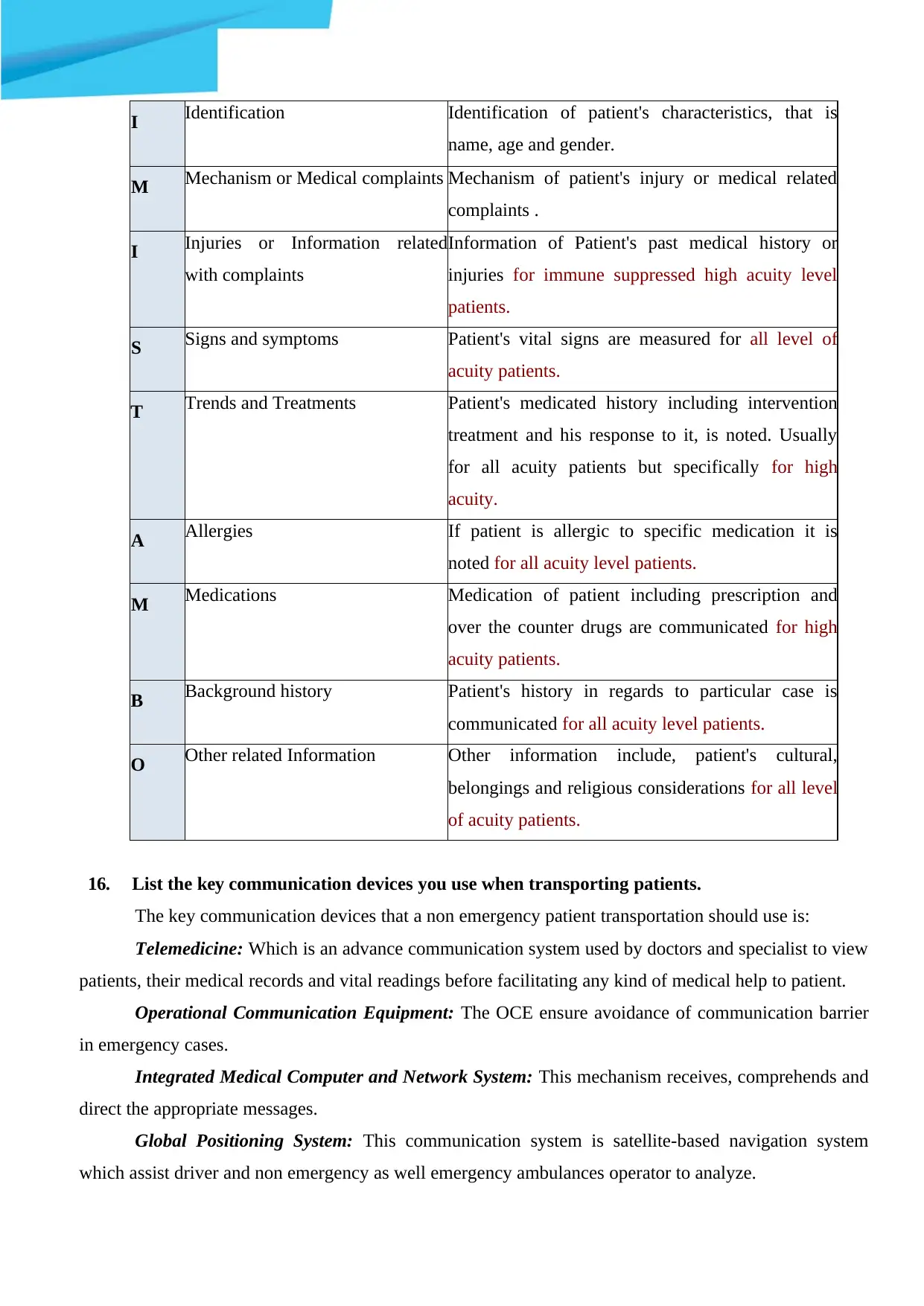
I Identification Identification of patient's characteristics, that is
name, age and gender.
M Mechanism or Medical complaints Mechanism of patient's injury or medical related
complaints .
I Injuries or Information related
with complaints
Information of Patient's past medical history or
injuries for immune suppressed high acuity level
patients.
S Signs and symptoms Patient's vital signs are measured for all level of
acuity patients.
T Trends and Treatments Patient's medicated history including intervention
treatment and his response to it, is noted. Usually
for all acuity patients but specifically for high
acuity.
A Allergies If patient is allergic to specific medication it is
noted for all acuity level patients.
M Medications Medication of patient including prescription and
over the counter drugs are communicated for high
acuity patients.
B Background history Patient's history in regards to particular case is
communicated for all acuity level patients.
O Other related Information Other information include, patient's cultural,
belongings and religious considerations for all level
of acuity patients.
16. List the key communication devices you use when transporting patients.
The key communication devices that a non emergency patient transportation should use is:
Telemedicine: Which is an advance communication system used by doctors and specialist to view
patients, their medical records and vital readings before facilitating any kind of medical help to patient.
Operational Communication Equipment: The OCE ensure avoidance of communication barrier
in emergency cases.
Integrated Medical Computer and Network System: This mechanism receives, comprehends and
direct the appropriate messages.
Global Positioning System: This communication system is satellite-based navigation system
which assist driver and non emergency as well emergency ambulances operator to analyze.
name, age and gender.
M Mechanism or Medical complaints Mechanism of patient's injury or medical related
complaints .
I Injuries or Information related
with complaints
Information of Patient's past medical history or
injuries for immune suppressed high acuity level
patients.
S Signs and symptoms Patient's vital signs are measured for all level of
acuity patients.
T Trends and Treatments Patient's medicated history including intervention
treatment and his response to it, is noted. Usually
for all acuity patients but specifically for high
acuity.
A Allergies If patient is allergic to specific medication it is
noted for all acuity level patients.
M Medications Medication of patient including prescription and
over the counter drugs are communicated for high
acuity patients.
B Background history Patient's history in regards to particular case is
communicated for all acuity level patients.
O Other related Information Other information include, patient's cultural,
belongings and religious considerations for all level
of acuity patients.
16. List the key communication devices you use when transporting patients.
The key communication devices that a non emergency patient transportation should use is:
Telemedicine: Which is an advance communication system used by doctors and specialist to view
patients, their medical records and vital readings before facilitating any kind of medical help to patient.
Operational Communication Equipment: The OCE ensure avoidance of communication barrier
in emergency cases.
Integrated Medical Computer and Network System: This mechanism receives, comprehends and
direct the appropriate messages.
Global Positioning System: This communication system is satellite-based navigation system
which assist driver and non emergency as well emergency ambulances operator to analyze.
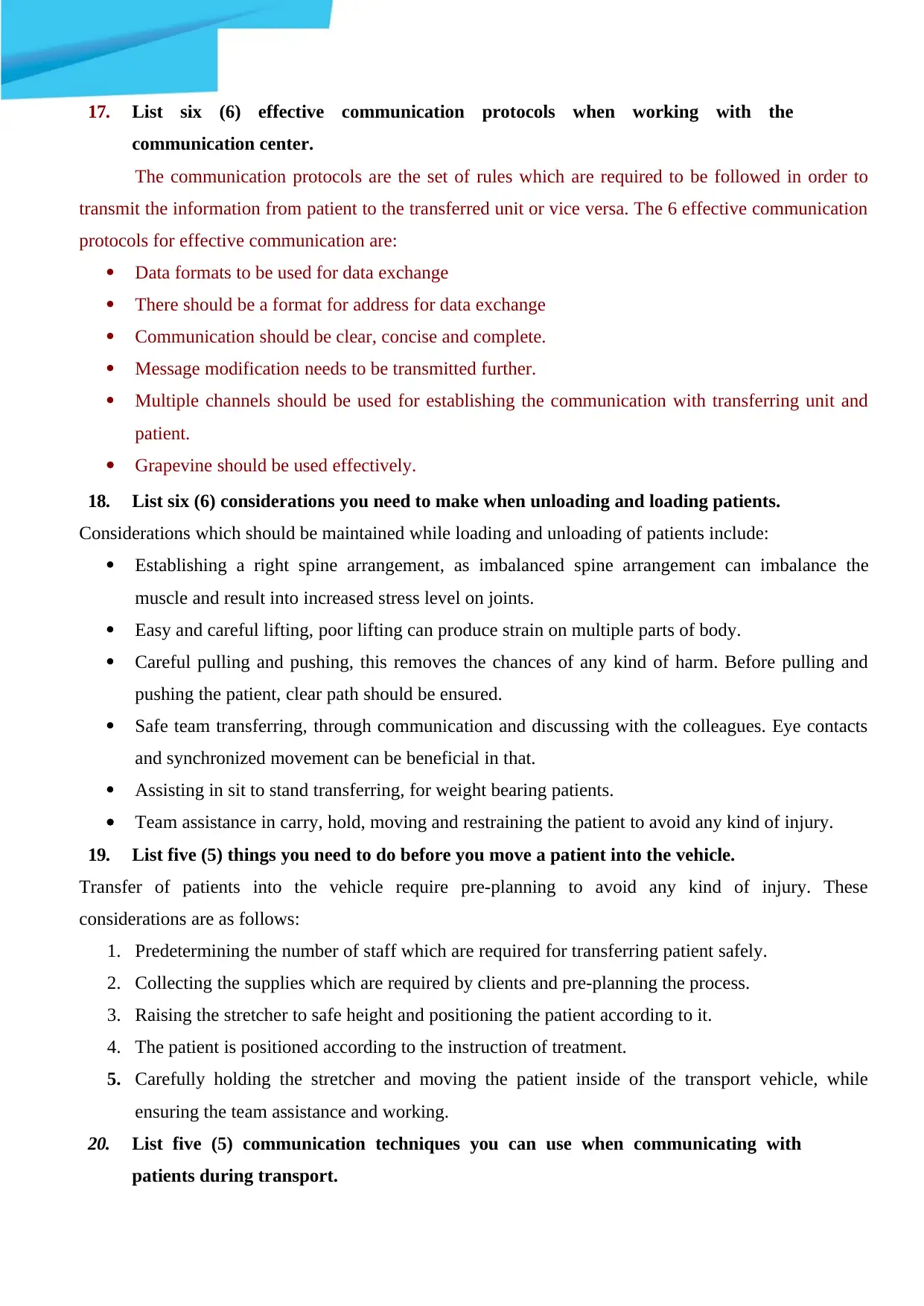
17. List six (6) effective communication protocols when working with the
communication center.
The communication protocols are the set of rules which are required to be followed in order to
transmit the information from patient to the transferred unit or vice versa. The 6 effective communication
protocols for effective communication are:
Data formats to be used for data exchange
There should be a format for address for data exchange
Communication should be clear, concise and complete.
Message modification needs to be transmitted further.
Multiple channels should be used for establishing the communication with transferring unit and
patient.
Grapevine should be used effectively.
18. List six (6) considerations you need to make when unloading and loading patients.
Considerations which should be maintained while loading and unloading of patients include:
Establishing a right spine arrangement, as imbalanced spine arrangement can imbalance the
muscle and result into increased stress level on joints.
Easy and careful lifting, poor lifting can produce strain on multiple parts of body.
Careful pulling and pushing, this removes the chances of any kind of harm. Before pulling and
pushing the patient, clear path should be ensured.
Safe team transferring, through communication and discussing with the colleagues. Eye contacts
and synchronized movement can be beneficial in that.
Assisting in sit to stand transferring, for weight bearing patients.
Team assistance in carry, hold, moving and restraining the patient to avoid any kind of injury.
19. List five (5) things you need to do before you move a patient into the vehicle.
Transfer of patients into the vehicle require pre-planning to avoid any kind of injury. These
considerations are as follows:
1. Predetermining the number of staff which are required for transferring patient safely.
2. Collecting the supplies which are required by clients and pre-planning the process.
3. Raising the stretcher to safe height and positioning the patient according to it.
4. The patient is positioned according to the instruction of treatment.
5. Carefully holding the stretcher and moving the patient inside of the transport vehicle, while
ensuring the team assistance and working.
20. List five (5) communication techniques you can use when communicating with
patients during transport.
communication center.
The communication protocols are the set of rules which are required to be followed in order to
transmit the information from patient to the transferred unit or vice versa. The 6 effective communication
protocols for effective communication are:
Data formats to be used for data exchange
There should be a format for address for data exchange
Communication should be clear, concise and complete.
Message modification needs to be transmitted further.
Multiple channels should be used for establishing the communication with transferring unit and
patient.
Grapevine should be used effectively.
18. List six (6) considerations you need to make when unloading and loading patients.
Considerations which should be maintained while loading and unloading of patients include:
Establishing a right spine arrangement, as imbalanced spine arrangement can imbalance the
muscle and result into increased stress level on joints.
Easy and careful lifting, poor lifting can produce strain on multiple parts of body.
Careful pulling and pushing, this removes the chances of any kind of harm. Before pulling and
pushing the patient, clear path should be ensured.
Safe team transferring, through communication and discussing with the colleagues. Eye contacts
and synchronized movement can be beneficial in that.
Assisting in sit to stand transferring, for weight bearing patients.
Team assistance in carry, hold, moving and restraining the patient to avoid any kind of injury.
19. List five (5) things you need to do before you move a patient into the vehicle.
Transfer of patients into the vehicle require pre-planning to avoid any kind of injury. These
considerations are as follows:
1. Predetermining the number of staff which are required for transferring patient safely.
2. Collecting the supplies which are required by clients and pre-planning the process.
3. Raising the stretcher to safe height and positioning the patient according to it.
4. The patient is positioned according to the instruction of treatment.
5. Carefully holding the stretcher and moving the patient inside of the transport vehicle, while
ensuring the team assistance and working.
20. List five (5) communication techniques you can use when communicating with
patients during transport.
⊘ This is a preview!⊘
Do you want full access?
Subscribe today to unlock all pages.

Trusted by 1+ million students worldwide
1 out of 18
Related Documents
Your All-in-One AI-Powered Toolkit for Academic Success.
+13062052269
info@desklib.com
Available 24*7 on WhatsApp / Email
![[object Object]](/_next/static/media/star-bottom.7253800d.svg)
Unlock your academic potential
Copyright © 2020–2025 A2Z Services. All Rights Reserved. Developed and managed by ZUCOL.





